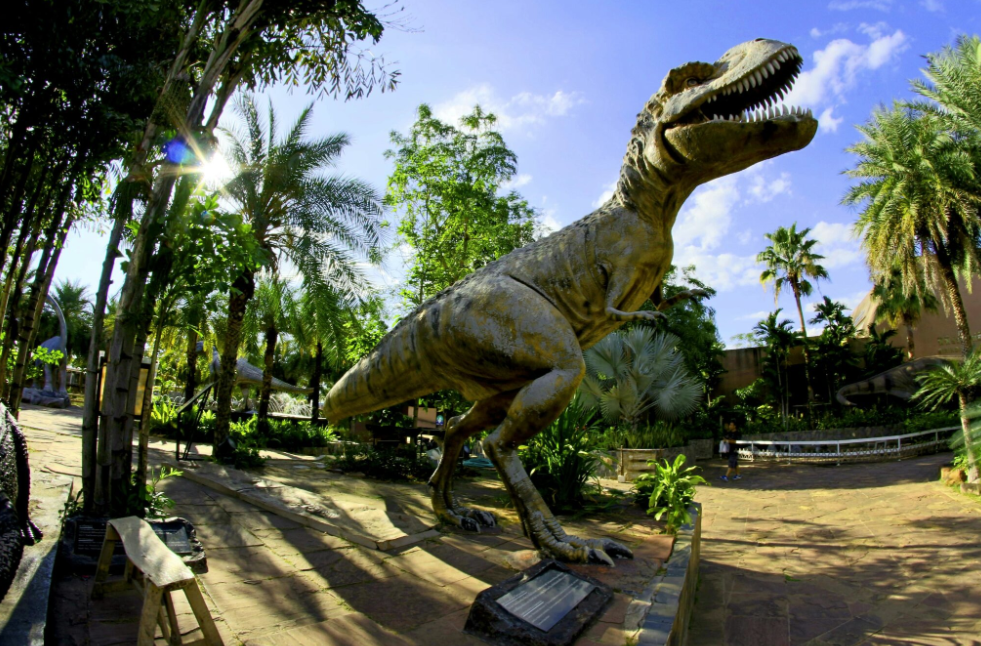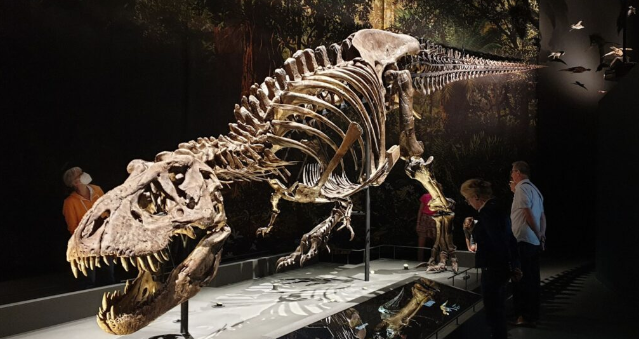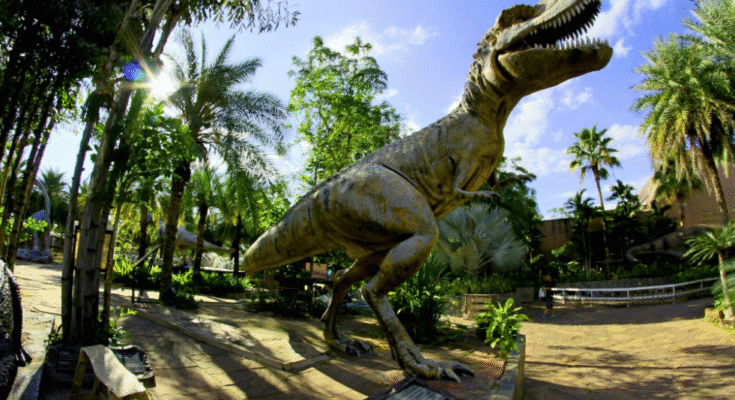
Sixty-six million years ago, the Tyrannosaurus rex ruled the Earth as a towering symbol of raw power and survival. Today, its legacy may soon hang from your shoulder—not as a fossil, but as a luxury handbag.
In a fusion of cutting-edge biotechnology and avant-garde fashion, scientists and designers are collaborating to create the world’s first T-Rex leather. Not imitation. Not plastic. Actual lab-grown material engineered from fragments of fossilized dinosaur collagen. It sounds like science fiction—or a marketing gimmick—but the project is very real and backed by ambitious claims: cruelty-free, biodegradable, and structurally identical to traditional leather.
Can prehistoric proteins really shape the future of sustainable fashion? Is this a genuine leap forward, or just a Jurassic-themed fantasy? As ancient biology collides with modern innovation, this bold experiment is raising big questions—not just about what’s possible in a lab, but about what we value in the things we choose to wear.
The Concept
What began as a speculative fusion of science and design is now poised to redefine the boundaries of sustainable luxury. The T-Rex leather project is the brainchild of a triad of innovation: global creative agency VML, genome engineering specialists The Organoid Company, and biofabrication pioneers Lab-Grown Leather Ltd. Their shared goal? To transform fossilized remnants of one of the most fearsome creatures in Earth’s history into a cruelty-free, high-end material for fashion.
At the heart of this project is a compelling idea—repurposing ancient biology to create something entirely new, yet oddly familiar. Instead of using conventional animal hides or petroleum-based synthetics, the team aims to bioengineer leather using a protein called collagen, which has been discovered in well-preserved Tyrannosaurus rex fossils. Collagen is the main structural component of skin and connective tissue, making it an essential ingredient in leather production.
T-Rex Luxury Bags? Scientists Plan To Use Leather From Dinosaur DNA https://t.co/6x3EEVf8GW pic.twitter.com/nv3yuJWwPA
— NDTV (@ndtv) May 6, 2025
To be clear, this isn’t about resurrecting dinosaurs or cloning extinct species. Rather, scientists are using recovered fragments of T-Rex collagen as a molecular guide. By synthesizing DNA sequences based on these fragments, they can instruct lab-grown cells to produce leather-like tissues. It’s not actual dinosaur skin, but a new material that’s biologically modeled on it—earning it the label “T-Rex leather.”
This bold venture stands at the intersection of storytelling and science, with the T-Rex serving both as a metaphor for resilience and a marketing symbol of exclusivity. As a brand narrative, it’s irresistible. As a scientific achievement, it’s pushing the limits of what’s possible in synthetic biology and tissue engineering.
If successful, the first luxury accessories made from this leather are expected to launch by the end of 2025. But beyond the novelty, the collaborators envision a paradigm shift—where the history of life on Earth inspires materials that are not only innovative but more responsible. Fossils, once static symbols of the past, are now being engineered into the future of fashion.
How It Works

The foundation of this innovation lies in collagen, a structural protein found in skin, tendons, and bones. In recent years, researchers have identified collagen remnants preserved in fossilized dinosaur bones, including those of the Tyrannosaurus rex. Unlike DNA, which degrades rapidly and has not been recovered intact from any Mesozoic-era creature, collagen can survive under rare conditions, encased within mineralized bone tissue.
Using these fossilized collagen fragments as a reference, scientists at The Organoid Company synthesized a complete collagen sequence that mirrors what might have existed in T-Rex. This sequence was encoded into synthetic DNA, then inserted into custom-engineered cell lines cultivated by Lab-Grown Leather Ltd. The result: living cells that produce collagen modeled after the ancient protein.
The engineered cells are then cultured in a scaffold-free system—a significant departure from other biofabrication methods that rely on artificial structures to shape tissue growth. Instead, these cells are allowed to self-organize, naturally developing into dense, skin-like layers that replicate the texture, structure, and durability of traditional leather.
The foundation of this innovation lies in collagen, a structural protein found in skin, tendons, and bones. In recent years, researchers have identified collagen remnants preserved in fossilized dinosaur bones, including those of the Tyrannosaurus rex. Unlike DNA, which degrades rapidly and has not been recovered intact from any Mesozoic-era creature, collagen can survive under rare conditions, encased within mineralized bone tissue.
Using these fossilized collagen fragments as a reference, scientists at The Organoid Company synthesized a complete collagen sequence that mirrors what might have existed in T-Rex. This sequence was encoded into synthetic DNA, then inserted into custom-engineered cell lines cultivated by Lab-Grown Leather Ltd. The result: living cells that produce collagen modeled after the ancient protein.
The engineered cells are then cultured in a scaffold-free system—a significant departure from other biofabrication methods that rely on artificial structures to shape tissue growth. Instead, these cells are allowed to self-organize, naturally developing into dense, skin-like layers that replicate the texture, structure, and durability of traditional leather.
Why It Matters

Traditional leather, often considered a luxury staple, comes with a heavy cost. The leather industry is a major contribution.
Animal welfare is another critical concern. Leather, while often viewed as a byproduct of the meat industry, still contributes to demand for livestock farming and the systemic issues surrounding it. For many modern consumers, especially younger generations, these ethical implications are increasingly unacceptable.
This is where lab-grown T-Rex leather attempts to redefine the paradigm. Engineered in controlled laboratory environments from cultured cells, it bypasses the need for raising, harming, or killing animals altogether. It’s cruelty-free by design. Furthermore, the material is biodegradable, addressing one of the common criticisms of both synthetic leathers (which are plastic-based) and chemically treated hides, which can persist in landfills for decades.
The use of scaffold-free cellular growth not only enhances the material’s quality but also minimizes manufacturing waste and external resource use. With no need for animal agriculture or harmful chemical baths, the environmental footprint of T-Rex leather could be a fraction of that associated with traditional methods.
Yet the ethical appeal goes beyond what it avoids. There’s something inherently bold—and oddly poetic—about using the biology of an extinct species to solve problems in a world facing its own existential threats. As climate change accelerates and biodiversity declines, materials like these signal a future where innovation doesn’t come at the planet’s expense.
In a marketplace where transparency and ethics are as important as aesthetics, T-Rex leather presents itself not just as a product of curiosity, but as a material solution aligned with 21st-century values.
The Skepticism

The most common critique centers around a fundamental point: there is no preserved Tyrannosaurus rex DNA. According to vertebrate paleontologist Dr. Thomas Holtz Jr. of the University of Maryland, the notion that T-Rex genes could be used to create any biological product is “misleading.” DNA begins degrading immediately after an organism dies, and even under exceptional conditions, fragments of DNA have only been recovered from specimens that are up to 2 million years old—a far cry from the T-Rex’s extinction 66 million years ago.
Instead, the project is based on fossilized collagen, a protein far more chemically stable than DNA. While some collagen remnants have been found in well-preserved dinosaur bones, they are highly fragmented and chemically altered by fossilization. These pieces may offer some structural clues, but as critics like Dr. Thomas Carr of the Carthage Institute of Paleontology note, they are insufficient to reconstruct a species-specific collagen sequence. And since collagen is a fairly universal molecule among vertebrates, any material made from reconstructed fragments is unlikely to be truly unique to the T-Rex.

There’s also skepticism about the marketing narrative. The term “T-Rex leather” implies a direct biological lineage to the extinct dinosaur, which scientists argue may overstate the connection. At best, the material is “inspired by” T-Rex collagen, reconstructed through a mixture of recovered data and synthetic extrapolation. At worst, some see it as a clever branding maneuver that leans more on science fiction than on verifiable science.
Still, the project’s backers remain adamant that their claims are not just hype. Professor Che Connon, one of the scientists behind the initiative, argues that the misunderstanding lies in confusing “leather” with “skin.” Leather is made from dermal collagen, which can be grown and engineered without needing intact skin samples. According to Connon, the technologies used are already validated in tissue engineering contexts—it’s just that applying them to luxury goods is what’s new.
And that may be the point. Whether or not the final product is truly “T-Rex” in a molecular sense, it represents a significant step forward in biofabrication and material innovation. It may not bring dinosaurs back to life, but it pushes the boundaries of what’s possible when storytelling, biotechnology, and sustainable design collide.
The Future of Fashion

Luxury fashion has always thrived on rarity and craftsmanship. T-Rex leather, by invoking the mystique of a long-extinct creature, amplifies that sense of exclusivity—but with a modern twist. Instead of sourcing materials from endangered animals or synthetic petrochemicals, it draws from extinct biology and synthetic life, aligning the concept of rarity with innovation rather than exploitation.
But perhaps more compelling is what this material could signal for the broader future of fashion. If lab-grown T-Rex leather proves viable, it opens the door to entirely new classes of designer materials: bioengineered fabrics tailored not just for appearance, but for performance, environmental impact, and even personalization. Think collagen leather with built-in durability or color-shifting properties—traits designed at the cellular level. Already, researchers are exploring how synthetic biology can create responsive textiles, self-repairing fabrics, and biodegradable components that displace the throwaway culture of fast fashion.
And the applications don’t end at fashion. The companies behind T-Rex leather envision its potential expanding into automotive interiors, smart textiles, and luxury furniture, reshaping industries that currently rely on animal-based or plastic-derived materials. As biofabrication techniques become more refined, future generations may look back at traditional leather production as a crude and wasteful practice from a less conscious time.
In that way, T-Rex leather is less about bringing dinosaurs into fashion and more about bringing fashion into a new epoch—one where sustainability, ethics, and scientific ingenuity are stitched into the very fabric of our wardrobes.
A Symbol, A Statement, A Start
At first glance, the idea of crafting handbags from Tyrannosaurus rex collagen might seem like a futuristic gimmick—a clever collision of science fiction and fashion marketing. But beneath the spectacle lies a deeper reflection of where we are as a society: caught between the urgency of climate change, the rise of ethical consumerism, and the limitless possibilities of synthetic biology.
The T-Rex leather project isn’t just a material innovation; it’s a cultural mirror. It asks us to consider what we value in luxury, and whether rarity, beauty, and prestige can coexist with responsibility, sustainability, and science. In using ancient biology to create modern, cruelty-free goods, the project turns the fossil record into a forward-looking blueprint—one that challenges our assumptions about where materials come from and what they mean.
In many ways, this innovation is a metaphor for our moment in history. As we face a climate increasingly marked by extremes—heat, drought, extinction—scientists are reaching back to organisms that survived the most brutal environmental conditions Earth has ever known. They’re not reviving the past for nostalgia’s sake, but reinterpreting it to solve the problems of today. It’s a reminder that survival, adaptability, and resilience aren’t just biological traits—they’re design principles.
Yet the project also forces a reckoning with how we talk about science and innovation. Can we embrace progress while remaining honest about its limitations? Can marketing ambition coexist with scientific integrity? These are the questions consumers, creators, and critics will need to ask—not just about T-Rex leather, but about any breakthrough that promises to change how we live and what we consume.
In the end, T-Rex leather is more than a fashion statement. It’s a conversation starter. It challenges us to envision a world where the materials we wear don’t harm the one we live in—and where the echoes of deep time might just help us build a more ethical future.


